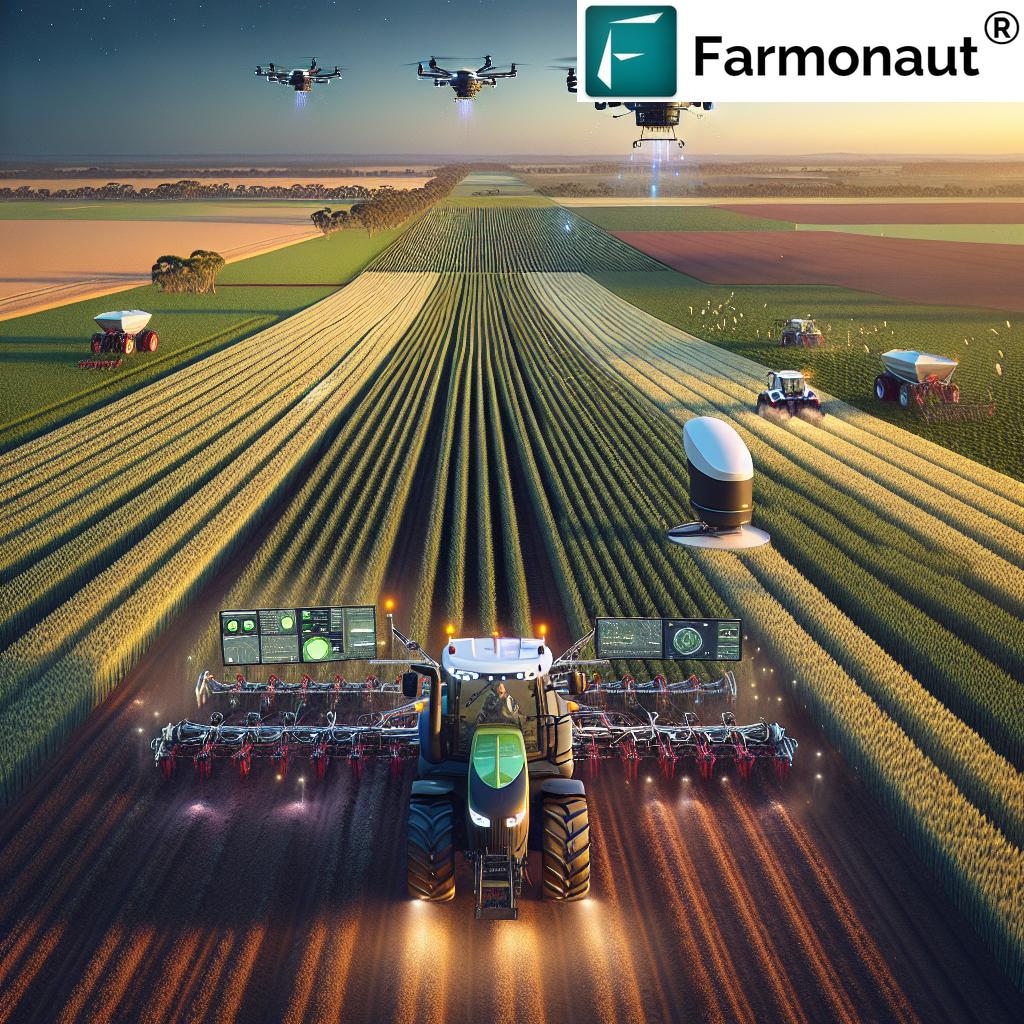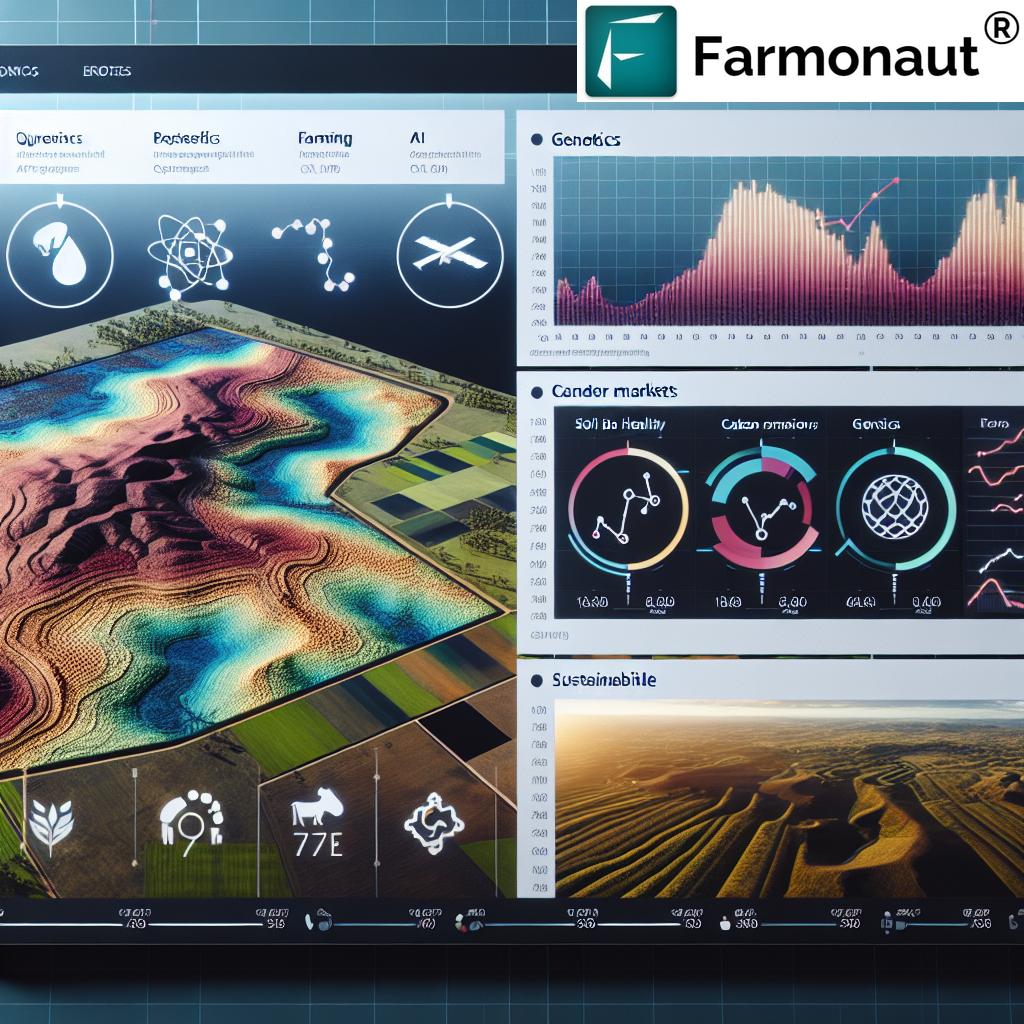2024 Outlook: Revolutionizing Australian Agriculture with Precision Farming and Sustainable Pasture Management

“By 2024, precision farming techniques are expected to increase crop productivity by up to 25% in Australian agriculture.”
As we approach 2024, the Australian agricultural landscape is poised for a revolutionary transformation. In this comprehensive blog post, we’ll explore the future of sustainable livestock management and agricultural technology adoption that’s reshaping our nation’s farming practices. From cutting-edge precision farming techniques to advanced pasture management systems, we’re witnessing a paradigm shift that promises to elevate our agricultural sector to new heights.
The Dawn of Precision Farming in Australia
Precision farming is no longer a futuristic concept but a present reality for many Australian farmers. As we look towards 2024, the adoption of these technologies is set to skyrocket, bringing about unprecedented changes in how we manage our crops and livestock.
- Satellite-Based Crop Monitoring: Companies like Farmonaut are at the forefront of this revolution, offering advanced satellite-based farm management solutions. Their platform provides real-time crop health monitoring, enabling farmers to make data-driven decisions about irrigation, fertilizer usage, and pest management.
- AI-Powered Advisory Systems: The integration of artificial intelligence in agriculture is transforming farm management. Farmonaut’s Jeevn AI advisory system, for instance, delivers personalized insights and expert crop management strategies, helping farmers optimize their productivity and efficiency.
- Blockchain for Traceability: The implementation of blockchain technology in agriculture ensures transparency and security in the supply chain, from farm to consumer. This not only enhances trust but also reduces fraud, a critical factor in today’s market-driven economy.
Sustainable Pasture Management: A Game-Changer for Livestock
The Australian livestock industry, particularly our cattle, sheep, and goat markets, is undergoing a significant transformation with the advent of sustainable pasture management systems. These innovative approaches are not only improving animal welfare but also boosting productivity and environmental sustainability.
- Remote Sensing for Pasture Quality: Satellite imagery and drone technology are being employed to assess pasture quality and quantity, allowing for more efficient grazing management.
- Rotational Grazing Systems: Advanced algorithms are helping farmers implement optimal rotational grazing patterns, ensuring better pasture utilization and recovery.
- Soil Health Monitoring: New technologies are enabling real-time monitoring of soil health, crucial for maintaining productive pastures and reducing environmental impact.
Agricultural Data Analytics: Powering Informed Decision-Making
In the era of big data, agricultural data analytics is becoming an indispensable tool for Australian farmers. By 2024, we expect to see a significant increase in the adoption of data-driven farming practices.
- Yield Prediction Models: Advanced analytics are helping farmers predict crop yields with greater accuracy, allowing for better resource allocation and market planning.
- Weather Pattern Analysis: Sophisticated weather prediction models, integrated with farm management systems, are enabling farmers to make proactive decisions in the face of Australia’s often unpredictable climate.
- Market Trend Analysis: Data analytics are providing invaluable insights into market trends, helping farmers align their production with demand and maximize profitability.
Explore Farmonaut’s API for advanced agricultural data analytics
Crop Productivity Optimization: Maximizing Yields Sustainably
As we move towards 2024, crop productivity optimization remains a key focus for Australian agriculture. The integration of various technologies is enabling farmers to achieve higher yields while minimizing environmental impact.
- Precision Irrigation Systems: Water-efficient irrigation systems, guided by soil moisture sensors and weather data, are helping farmers optimize water usage.
- Variable Rate Technology (VRT): VRT allows for precise application of inputs like fertilizers and pesticides, reducing waste and improving crop health.
- Genetic Improvements: Advancements in crop genetics are producing varieties more resistant to pests, diseases, and environmental stresses, leading to improved yields.
“Advanced pasture management systems could reduce livestock methane emissions by 30% while improving soil health by 40%.”
Soil Health Monitoring: The Foundation of Sustainable Agriculture
Soil health is the cornerstone of sustainable agriculture, and by 2024, we anticipate widespread adoption of advanced soil monitoring technologies across Australia.
- Real-Time Soil Sensors: In-situ sensors are providing continuous data on soil moisture, temperature, and nutrient levels, allowing for timely interventions.
- Spectral Analysis: Advanced spectroscopic techniques are enabling rapid, non-destructive analysis of soil composition and health.
- Microbiome Mapping: Understanding and managing soil microbiomes is emerging as a key strategy for enhancing soil health and crop productivity.
Access Farmonaut’s API Developer Docs for soil health monitoring integration
Agribusiness Market Insights: Navigating the Future
As we look towards 2024, understanding market trends is crucial for Australian agribusinesses. Here’s what we’re forecasting for key sectors:
- Wheat Market: With global demand for wheat expected to rise, Australian producers are positioned to benefit from increased exports, provided they can maintain quality and competitiveness.
- Sheep and Goat Markets: The demand for Australian lamb and goat meat is projected to grow, particularly in Asian markets, driven by increasing consumer preference for high-quality protein sources.
- Cattle Industry: The beef sector is likely to see continued strong demand, with a focus on sustainability and traceability becoming increasingly important for international buyers.
| Agricultural Technology Type | Current Adoption Rate (%) | Projected 2024 Adoption Rate (%) | Potential Impact on Farm Productivity (%) |
|---|---|---|---|
| Precision farming systems | 35 | 60 | +20 |
| Remote sensing applications | 40 | 70 | +15 |
| Advanced pasture management tools | 25 | 55 | +25 |
| Soil health monitoring devices | 30 | 65 | +18 |
| Livestock genetics and breeding programs | 45 | 75 | +22 |
| Carbon emissions management solutions | 20 | 50 | +10 |
Climate-Smart Agriculture: Adapting to Environmental Challenges
With climate change posing significant challenges to Australian agriculture, the adoption of climate-smart practices is becoming increasingly critical.
- Drought-Resistant Crop Varieties: Investment in developing and adopting drought-resistant crop varieties is helping farmers maintain productivity in the face of water scarcity.
- Carbon Sequestration Practices: Techniques like no-till farming and cover cropping are being widely adopted to improve soil health and sequester carbon.
- Renewable Energy Integration: Many farms are incorporating solar and wind energy to reduce their carbon footprint and operational costs.
Remote Sensing in Agriculture: Eyes in the Sky
Remote sensing technologies are revolutionizing how we monitor and manage agricultural lands. By 2024, we expect these technologies to be mainstream in Australian farming practices.
- Satellite Imagery: High-resolution satellite imagery is providing farmers with regular, comprehensive views of their land, enabling early detection of issues like pest infestations or nutrient deficiencies.
- Drone Technology: Drones equipped with multispectral cameras are being used for detailed crop scouting, offering insights that were previously impossible to obtain.
- IoT Sensors: Networks of Internet of Things (IoT) sensors are creating a detailed picture of farm conditions, from soil moisture to crop growth stages.
Genetics and Breeding: Enhancing Livestock Performance
Advancements in genetics and breeding programs are set to significantly impact Australia’s livestock industry by 2024.
- Genomic Selection: The use of genomic data is allowing for more accurate selection of superior breeding stock, leading to rapid genetic gains in desirable traits.
- Gene Editing: While still in its early stages, gene editing techniques like CRISPR hold promise for developing livestock with enhanced disease resistance and productivity.
- Reproductive Technologies: Advanced reproductive technologies are enabling faster propagation of superior genetics throughout herds and flocks.
Global Agricultural Trade: Australia’s Position
As we approach 2024, Australia’s position in global agricultural trade remains strong, with several factors influencing our outlook:
- Free Trade Agreements: Ongoing negotiations and existing FTAs are opening up new markets for Australian agricultural products.
- Quality and Safety Standards: Australia’s reputation for high-quality, safe agricultural products continues to be a significant advantage in international markets.
- Sustainability Credentials: Our focus on sustainable farming practices is increasingly valued by environmentally conscious global consumers.
Carbon Emissions Management: A New Frontier
Managing carbon emissions is becoming an integral part of Australian farming practices, driven by both environmental concerns and market demands.
- Carbon Farming Initiatives: Government programs are incentivizing farmers to adopt practices that reduce emissions and sequester carbon.
- Methane Reduction in Livestock: Research into feed additives and breeding programs aimed at reducing methane emissions from livestock is progressing rapidly.
- Renewable Energy Adoption: Many farms are transitioning to renewable energy sources, reducing their carbon footprint and operational costs.
The Future of Sustainable Agriculture in Queensland and Beyond
Queensland, as a major agricultural state, is at the forefront of many sustainable agriculture initiatives that will shape the industry’s future:
- Water Management: Innovative irrigation techniques and water-saving technologies are being widely adopted to cope with the state’s variable climate.
- Tropical Agriculture Research: Queensland’s unique climate is driving research into tropical and subtropical crop varieties suited to changing environmental conditions.
- Agritourism: The integration of tourism with sustainable farming practices is creating new revenue streams for farmers while promoting agricultural awareness.
Upcoming Workshops and Research Projects
To stay at the cutting edge of agricultural innovation, numerous workshops and research projects are planned for 2024:
- Precision Agriculture Workshops: Hands-on training sessions for farmers on implementing precision farming technologies.
- Soil Health Symposiums: Bringing together researchers and farmers to discuss the latest in soil management practices.
- AgTech Hackathons: Events encouraging the development of innovative agricultural technology solutions.
- Climate Adaptation Research: Ongoing projects studying crop and livestock adaptations to changing climate conditions.
Conclusion: Embracing the Agricultural Revolution
As we look towards 2024, the Australian agricultural sector stands on the brink of a technological and sustainable revolution. The integration of precision farming, advanced pasture management, and data-driven decision-making is set to transform our industry, enhancing productivity, sustainability, and profitability.
From the vast wheat fields to the sprawling cattle stations, every aspect of Australian agriculture is being touched by this wave of innovation. The challenges are significant, but so are the opportunities. By embracing these new technologies and practices, Australian farmers and agribusinesses are not just securing their own future but are also playing a crucial role in feeding a growing global population sustainably.
As we navigate this exciting future, staying informed and adaptable will be key. The agricultural landscape of 2024 will reward those who are willing to innovate, collaborate, and lead the charge towards a more sustainable and productive farming sector.
FAQs
- What is precision farming, and how is it changing Australian agriculture?
Precision farming uses technology like GPS, sensors, and data analytics to optimize crop management. It’s revolutionizing Australian agriculture by enabling more efficient use of resources, improving yields, and reducing environmental impact. - How are sustainable pasture management systems benefiting livestock farmers?
These systems use advanced monitoring and rotational grazing techniques to improve pasture quality, increase livestock productivity, and reduce environmental impact. They’re helping farmers manage their land more effectively and sustainably. - What role does remote sensing play in modern agriculture?
Remote sensing, using satellites and drones, provides farmers with valuable data on crop health, soil conditions, and land use. This information helps in making informed decisions about irrigation, fertilization, and pest management. - How is Australia positioning itself in the global agricultural trade for 2024?
Australia is leveraging its reputation for high-quality, safe products and sustainable farming practices. Free trade agreements and a focus on meeting international standards are key to maintaining and expanding our global market presence. - What are some key challenges facing Australian agriculture in 2024?
Major challenges include adapting to climate change, managing water resources, reducing carbon emissions, and staying competitive in global markets. However, these challenges are driving innovation and adoption of new technologies.







